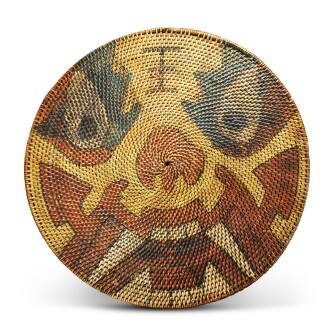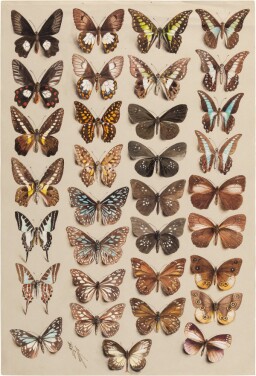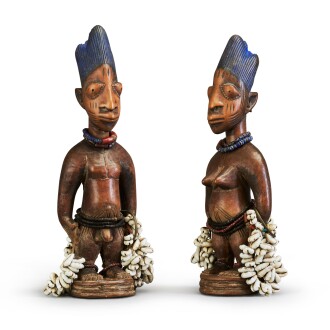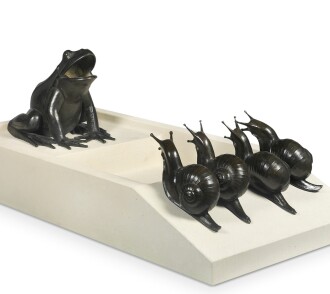T he taste and style of Peter and Leonora Petrou is inimitable - the wonderful, exotic, provocative and curious items they collect, often in stark juxtaposition is captivating, yet there always remains a symbiotic relationship, a conversation between the works they present, a convergence across centuries and continents.
With items ranging from the dawn of time to the present and encompassing the globe, the sale is in many ways an anthropological tour. Peter and Leonora’s ability to elevate the seemingly mundane into works of art through their appreciation of craftsmanship and exacting presentation is remarkable and Sotheby’s is thrilled to present this eclectic and exciting sale.
Peter and Leonora Petrou - Worldly Collectors

Peter and Leonora Petrou have been dealing in antiques and works of art for over four decades, initially from retail premises including Westbourne Grove in Notting Hill but also from their exhibitions at the Grosvenor House Fine Art and Antique Fair, Masterpiece and PAD in London and The Winter Antique Show at the Armory in New York.
Whilst they are known for diverse objects encompassing works of art from many cultures and periods in history, from antiquity to the present day and from Europe, across the globe to Rarotonga and the East, they have also been quietly involved in the Contemporary Fine Art Market and have amassed an equally varied collection of paintings and sculptures from living artists.

They have enjoyed searching out and drawing together the designs of the British Modernist furniture maker, Gerald Summers, whose company, “Makers of Simple Furniture” existed for only a brief period in the 1930s due to the outbreak of WWII, but whose designs were hugely popular both in the UK and the US.
This auction gives us a unique insight into the world of Peter and Leonora and the extraordinary works they have curated with joy.

In 1886, the discovery of the world’s largest gold deposits on the Witwatersrand in present-day South Africa and the ensuing gold rush was to change the region forever.
The profitability of the South African gold-mining industry depended on the supply of cheap labour from neighbouring countries, including present-day Tanzania, Zimbabwe, Botswana, and in particular Mozambique. The Portuguese colonial government allowed an annual recruitment of 100,000 labourers from the rural southern provinces of Mozambique, where the Shangaan people lived, accounting for up to 60% of underground mine workers in the Transvaal. The Shangaan were forced to pay for their own visas, transport and clothing, and to work in harsh and dangerous conditions, while their salaries were deferred, paid in gold directly to the Portuguese government.
Anton van Wouw was one of the only artists of the day to examine the plight of these urbanised migrant labourers and the terrible working and living conditions they endured.
Read Less
- India
- New Caledonia Islands

Featured Lots

Featured Lots

Featured Lots

Featured Lots
Gerald Summers – Design Visionary

Gerald Summers (1899-1967) was at the forefront of British modern design and arguably creative thinking in the 1930s. His designs reflected exciting new materials (most famously plywood), social change and a rejection of unnecessary ornament. Practical and beautiful, his work captured the artistic zeitgeist of this pre-war period and is an important part of great 20th century design.
At 16 years of age, Summers embarked upon an apprenticeship with the engineering firm Ruston and Proctor, which had a lasting impression as they produced moulded plywood fuselages for aircraft. From 1929 onwards, whilst working for Marconi, he also furnished his London flat with his own perfectly engineered designs.

These personal pieces were conceived considering function, then material, then form – a doctrine that was to be a constant in his work. He went on to produce furniture for the fashion house Rose and Blairman, a progressive atelier founded in 1929. Early commissions such as this led to a small body of work and, in 1931, the foundation of a company by Summers and his wife Marjorie which they christened ‘Makers of Simple Furniture’.

Through advertising sheets and important retailers acquiring work, he became known on both sides of the Atlantic. Collaborations with the architect Oliver Falvey Hill and Jack Pritchard, founder of Isokon, furthered his reputation and an exhibition at the RIBA in 1936 helped bring his designs to a wider audience. His work, some of which is offered here, is an exceptional legacy in the history of British and International design and reflects an early quote by Summers that ‘sight too will be satisfied’.
















































































